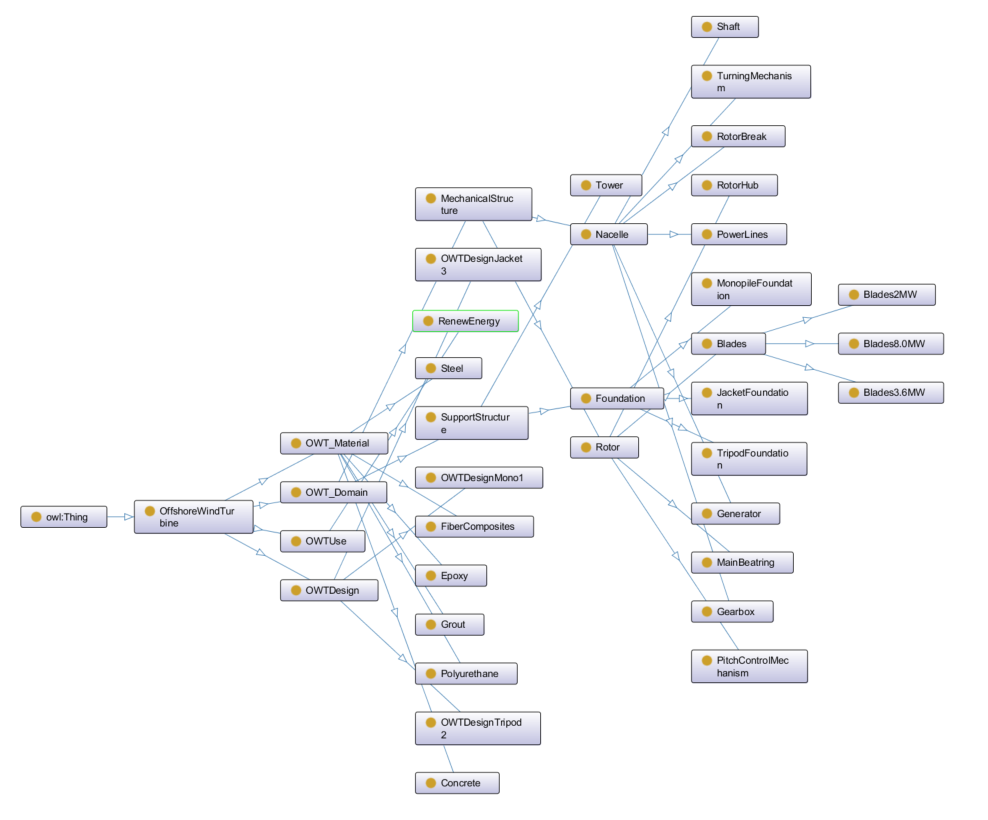Introduction
Offshore wind turbines represent an important technology for generating renewable energy technology and use the power of the wind to generate clean and sustainable electricity. Offshore wind turbines are complex systems of components carefully designed to withstand the demanding environmental conditions of the sea and wind. The construction of offshore wind turbines requires a multifaceted approach that includes mechanical, electrical and structural principles. The towering structures are made up of various key components, each playing a crucial role in the overall functionality of the system. This report focuses on the development of a parametric model for offshore wind turbines for different environmental conditions. Two significant high-performance criteria (HPC in the following) are energy output and structural stability. The parametric model provides a straightforward approach for different design options, which are required due to changing wind loads, water depths and soil conditions. Figure 1 shows a schematic representation of offshore wind turbines with different foundations.
![Fig. 1: Schematic representation of an offshore wind turbine with different foundations [6]](http://130.149.22.198/wp/wp-content/uploads/2024/02/Figure1_support-structure.png)
different foundations [6]
![Figure 2: Evolution of wind turbine sizes within the last 26 years.[1]](http://130.149.22.198/wp/wp-content/uploads/2024/02/EvolutionOWT.jpg)
What is the purpose?
The ontology is developed to demonstrate an example of the conceptual design of offshore wind turbines to provide an easy-to-understand design framework and make this much-needed renewable energy generation technology more accessible. In addition to the various shown system elements, an attempt is also made to illustrate their interrelationships.
What is the scope?
The domain shows a concept for offshore wind turbine systems in different water depths and soil conditions. The ontology also includes information like the structure, the components, and the materials. In this ontology, the scope will be to show three different offshore wind turbines with different foundations.
Who are the intended users?
The intended end-users are engineers, researchers, and construction and maintenance contractors for offshore wind turbines or renewable energies. With the use of this ontology, they can access comprehensive information about the system, its components, and materials and the different foundation types, which are necessary for different water depths.
What is the intended use?
planning. The development of an ontology always lacks a universal methodology; each approach contributes to an ontology with improved clarity, understandability, and error resolution. By [5], an essential aspect of ontology creation is to establish boundaries, preventing user overwhelm or confusion. They provide a wide array of suggestions that can be employed during ontology development.
Components
![Figure 3: Schematic representation of a system recording of the off- shore wind turbine. [7]](http://130.149.22.198/wp/wp-content/uploads/2024/02/OWT-Design_Paper2_2.png)
shore wind turbine. [7]
Ontograf

Engineering Examples
Optimizing Offshore Wind Turbine Foundation Design:
Use Case: The ontology serves as a guide for engineers, providing insights into suitable foundation types and materials based on seabed characteristics and water depths. It assists in selecting the most appropriate design elements, such as pile types and dimensions, considering factors like water depth and soil properties. Engineers could utilize ontology to create a parametric model for structural analysis, ensuring the optimized foundation design meets the required performance standards.
Integration of Advanced Monitoring Systems for Offshore Wind Turbines:
Use Case: Engineers use the ontology to understand the components and technologies available for advanced monitoring systems. The ontology offers insights into sensor types, communication protocols, and data analysis methods suitable for offshore wind turbines. By utilizing the ontology, engineers design a comprehensive monitoring system, considering factors like turbine health, environmental conditions, and predictive maintenance needs (The ontology needs to be expanded for this case).
References
[1] Afewerki, S., 2019. Firm agency and global production network dynamics. European Planning Studies 27, 1483–1502.
[2] Deutschland, B., 2023. Mehr energie aus erneuerbaren quellen -energiewende beschleunigen.
[3] GmbH, Z.O., 2023. Energiemonitor – die wichtigsten daten zur Energieversorgung.
← Individual Systems | Parametric Model →